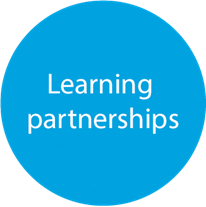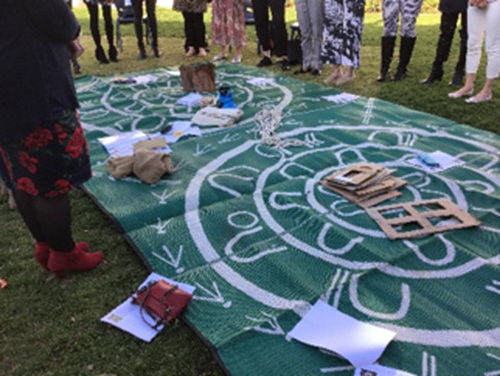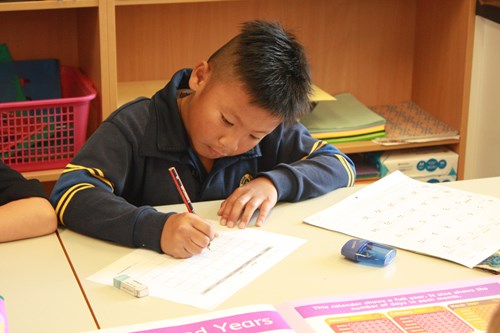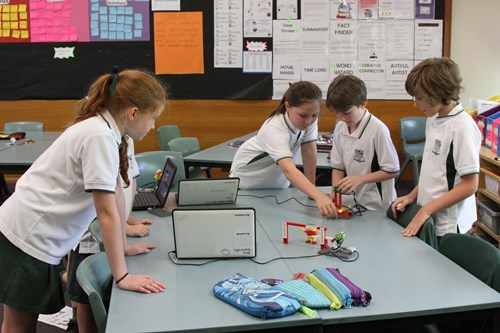Education sectors around the country have been developing and consolidating resources to assist continuity of learning during the period of remote education. The links below will take you to publicly available resources as of publication date.
|
Australian Capital Territory |
||
|
New South Wales |
https://education.nsw.gov.au/teaching-and-learning/curriculum/learning-from-home |
|
|
Northern Territory |
https://nt.gov.au/learning/learning-together
|
|
|
Queensland |
https://education.qld.gov.au/curriculum/learning-at-home
|
|
|
South Australia |
https://www.education.sa.gov.au/our-learning-sa
|
|
|
Tasmania |
https://www.education.tas.gov.au/learning-at-home/
|
|
|
Victoria |
https://education.vic.gov.au/school/teachers/teachingresources/Pages/coronavirus-home-learning.aspx
|
|
|
West Australia |
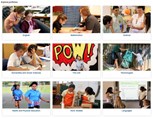 The Australian Curriculum website has work sample portfolios comprising samples of student work. The work samples listed for each year level can be replicated in the home learning environment with or without the need for internet access. Visit the Australian Curriculum website to view the work samples for all learning areas.
The Australian Curriculum website has work sample portfolios comprising samples of student work. The work samples listed for each year level can be replicated in the home learning environment with or without the need for internet access. Visit the Australian Curriculum website to view the work samples for all learning areas.
|
|
Foundation |
Year 1 |
Year 2 |
Year 3 |
Year 4 |
Year 5 |
Year 6 |
|
HASS: F–6/7 HASS
|
|||||||
|
The Arts
|
Dance
Drama Scripted performance: Goldilocks and the three bears (adapt by choosing just one scene)
Media Arts
Music (adapt – use household objects and voices as instruments)
Visual Arts Sharing stories: picture book |
Dance
Drama Scripted performance: Goldilocks and the three bears (adapt by choosing just one scene)
Media Arts
Music (adapt – use household objects and voices as instruments)
Visual Arts Sharing stories: picture book
|
Dance
Drama Scripted performance: Goldilocks and the three bears (adapt by choosing just one scene)
Media Arts
Music (adapt – use household objects and voices as instruments)
Visual Arts Sharing stories: picture book
|
Dance Telling stories (adapt for a smaller group)
Drama Scripted performance: Goldilocks and the three bears (adapt by using another story)
Media Arts (adapt using a different HASS topic)
Music (adapt – use household objects and voices as instruments)
Visual Arts |
Dance Telling stories (adapt for a smaller group)
Drama Scripted performance: Goldilocks and the three bears (adapt by using another story)
Media Arts (adapt using a different HASS topic)
Music (adapt – use household objects and voices as instruments)
Visual Arts |
Dance
Drama (adapt for two people – one actor and one narrator, use stories students are reading for English or leisure stories.
Media Arts
Music Composition: penguins soundscape (adapt – use household objects and voices as instruments)
Visual Arts |
Dance
Drama (adapt for two people – one actor and one narrator, use stories students are reading for English or leisure stories.
Media Arts
Music Composition: penguins soundscape (adapt – use household objects and voices as instruments)
Visual Arts |
|
Technologies: Design and Technologies
|
|||||||
|
Technologies: Digital Technologies |
(at home – the garden) |
(at home – the garden) |
(at home – the garden) |
(at home – room/house) |
(at home – room/house) |
|
|
|
Health and Physical Education
|
ACARA’s curriculum specialists have contributed some tips for continued learning at home:
|
English |
|
Students can: |
|
|
|
|
|
|
|
Mathematics |
|
Students can: |
|
|
|
|
|
|
|
|
|
|
|
|
|
|
Science |
|
Students can: |
|
|
|
|
|
|
|
Humanities and Social Sciences (HASS) |
|
Students can: |
|
|
|
|
|
The Arts |
|
Students can: |
|
|
|
|
|
|
Dance
|
|
Drama
|
|
Media Arts
|
|
Music
|
|
Visual Arts
|
|
Technologies (Design and Technologies and Digital Technologies) |
|
Students can: |
|
|
|
|
|
|
|
|
|
|
|
|
|
Health and Physical Education |
|
Students can: |
|
|
|
|
|
|
|
|
|
|
|
|
|
Languages |
|
Students can: |
|
|
|
|
|
|
|
https://www.esa.edu.au/solutions/our-solutions/language-learning-space |

The Digital Technologies in Focus (DTIF) team have been collecting and curating a host of resources to assist schools, parents and carers to support learning for remote learning.
The DTIF Wiki http://bit.ly/acarawiki has a special COVID-19 support area with:
- advice for online and remote learning, including devising a school learning continuity plan
- helpful videos, including tutorials for using technology and teaching learning area content
- resources curated by topic and type, including a section called ‘Learning with no technology’ https://sites.google.com/view/dtifwiki/learning-with-no-technology with suggested activities to keep students stimulated and curious. This section has information on all kinds of learning and student wellbeing, as well as collected advice from state and territories about their learning at home websites and recommendations.
The DTIF ‘Resources’ page https://www.australiancurriculum.edu.au/resources/digital-technologies-in-focus/resources/on the Australian Curriculum website https://www.australiancurriculum.edu.au/ has a number of resources that teachers, parents and carers will find useful, including:
- computational thinking in practice F–2 (parent and teacher activity cards) https://tinyurl.com/DTIF-CT-parent-cards
- books for exploring digital technologies concepts https://tinyurl.com/DTIF-books
- exploring patterns and data with bread tags and plastic lids (Years F–2) https://www.australiancurriculum.edu.au/media/5540/classroom-ideas-f-2-bread-tags.pdf
- building digital systems with recyclable materials https://www.australiancurriculum.edu.au/media/5899/classroom-ideas-f-2-digital-systems.pdf
Using computational thinking as a framework for literacy and numeracy activities
By Sarah Atkins, Curriculum Officer, Digital Technologies in focus project
The Australian Curriculum: Digital Technologies is not all about digital devices. One of the key ideas is computational thinking, a problem-solving method for creating solutions that can be implemented using digital technologies. It gives us a framework to align digital technologies with literacy and numeracy. The digital device is secondary to the thinking.
Computational thinking involves logically organising data, breaking down problems into parts, interpreting patterns and models and designing and implementing algorithms.
Taking a closer look, we ask students to use decomposition, which is breaking down of problems into parts, so they are easier to solve. Students then organise and analyse data through the use of pattern recognition to look for patterns to make sense of data. We encourage students to use abstraction to remove unnecessary details and focus on important data. Next, students use modelling and simulation to create models or simulations to represent processes.
Students then create algorithms – a series of ordered steps taken to solve a problem and apply them to create a solution.
Finally, students use evaluation to determine the effectiveness of their solution, generalise and apply their solution to new problems. Download our Computational thinking poster.
The following example shows computational thinking used as a framework for a literacy activity with opportunities for numeracy practice to be included.
Task:
Create a recount of ‘a day in my school at home life’.
Step 1: decomposition – break the day into parts. For example, before school session, morning session, afternoon session, after school activities, family time.
Step 2: pattern recognition – look for easily recordable chunks of time. For example, record activity time in 2-hour slots: 7–9 am, 9–11 am, 12–2 pm, 3–5 pm, 5–7 pm.
Step 3: abstraction – focus on important details. The recount shouldn’t be a blow-by-blow account. Record main activities as dot points. For example:
7–9 am
- eat breakfast
- brush teeth
- get dressed
9–11 am
- English
- HASS/Languages
12–2 pm
- Mathematics
- Science/Technology
3–5 pm
- Music/Arts practice
- Exercise
5–7 pm
- play
- eat dinner
- shower and brush teeth
- read
Step 4: modelling and simulation – organise dot points into a timetable, using pen and paper or a digital device. This way of presenting the data is easy to read.
Step 5: algorithms – create a series of ordered steps to tell a story in an interesting way. This gives students an opportunity to use some writing techniques such as a sizzling start, tightening the tension, adding a funny anecdote and ending with impact.
Students with access to digital devices could create a multimodal text using PowerPoint with hyperlinks or a visual programming language such as Scratch Jr or Scratch. This gives the student opportunities to incorporate decision-making and repetition into their recount.
Step 6: evaluation – as students create their recount, they can generalise, recognising repetitive code and reuse frequently used code sequences.
When the focus is taken off the devices and placed on the thinking process, it’s easy to incorporate literacy and numeracy into digital technologies. You’ll find more classroom ideas on the DTiF section of the Australian Curriculum website. We also have information on teaching remotely on our DTiF wiki.
By Patrick Kelly, Curriculum Specialist, Student Diversity
During these times of remote learning, ACARA continues its commitment to the development of a high-quality curriculum that meets the diverse needs of Australian students, one that promotes excellence and equity. As such, ACARA continues to liaise with its advisory groups and external stakeholders to provide resources to support families and schools. The following resources have been provided by some of these groups.
The Raising Children Network’s new Coronavirus (COVID-19), physical distancing and children with disability, autism and other conditions is now live. This document provides some very timely advice to parents who are supporting their children with their learning at home.
Key points:
- If you have children with disability at home during coronavirus (COVID-19), you might be dealing with child anxiety, daily care activities, learning at home, and sibling needs.
- It can help to talk through anxiety, use routines, get organised with learning, and try to balance all children’s needs.
- Looking after yourself and seeking support in this situation is good for you and good for your children.
- By physical distancing and staying at home during coronavirus (COVID-19), you are helping to protect everyone in your community.
The Children and Young People with Disability and the Australian Coalition for Inclusive Education developed a resource for families Learning at home during a time of crisis: COVID-19. This resource supports key advice to families and schools on what children and young people with disability need:
- clear communication with students and families about what is happening including what to do about keeping children and young people with disability safe and socially connected
- a strategy to ensure social connectedness. Students who have been previously disengaged, not supported with whole-of-school communication approaches, experienced bullying or significantly impacted by COVID19 changes need targeted solutions and support
- a spirit of collaboration that recognises that not all students have been fully included prior and that not all students feel safe and supported at home
- clear learning plans for students with disability including making reasonable adjustments to curriculum materials and class lessons
- flexible arrangements for accessing learning material, classmate and peer interactions and assessment, including need for accessible material and smaller group work online
- no penalty for needing flexible arrangements, targeted support for classmate and peer connections or greater support because of educational or social inequality.
The Australian Association for the Education of the Gifted and Talented advises that, as the COVID-19 pandemic widens, feelings such as helplessness, isolation and fear can escalate along with genuine and deep concern for others as well as their own learning progression. Other gifted children may relish in new-found opportunities to explore passion areas to a greater depth and complexity, or investigate entirely new areas of challenge.
There are number of considerations teachers can make to ensure that gifted and talented children are receiving a relevant and rigorous education during remote learning:
- provide opportunities for a learning scaffold within their zone of proximal development
- structure the learning to encourage use of higher order thinking skills and include opportunities to access the curriculum above the age level
- provide options to present a range of expressions of their learning
- connect them to opportunities for discussion of work and learning experiences with like-minded/ability peers and/or mentors
- continue to monitor the level at which they are working, including the use and application of pre-testing and above-level testing.
There are several online resources that teachers can share with families of gifted students. Whilst the list is exhaustive, and is often guided by the students' passions and interests, these resources may be helpful:
- Khan Academy offers practice exercises, instructional videos, and a personalised learning dashboard that empower learners to study at their own pace, along with free tools for parents and teachers.
- Educational companies offer free subscriptions and resources for the coronavirus (COVID-19) school closures.
The Australian Council of TESOL Associations (ACTA) is the national professional body representing teachers of English to speakers of other languages in Australia. ACTA suggests that teachers seeking additional resources and professional learning opportunities visit state or territory TESOL association websites and updates on resources.
Some key points for supporting EAL/D learners during this time of online learning include:
- choosing or making texts that are largely accessible to your language learners (comprehensibility)
- provide opportunities to repeat reading, writing, speaking and listening tasks
- share good examples of the kind of text (spoken or written) that you want your students/children to produce
- communicate the EAL/D or learning support teacher of your/ your child's school.
The ongoing COVID-19 pandemic has resulted in a large number of Australian students learning from home, with many parents and carers keen for resources to support them in the learning.
As ACARA CEO David de Carvalho noted in a recent opinion piece, “Many parents of school-age children are now dealing with a new reality, trying to keep their children engaged in learning while not having the professional skills that trained teachers bring to that complex and vitally important task.
“Government education departments, Catholic school systems and independent schools have been working with remarkable speed and intensity to put in place or ramp up online learning mechanisms to help. They are preparing high-quality learning materials, linked to the Australian Curriculum, which help parents to keep their children engaged in learning under these most unusual circumstances.”
ACARA has compiled a range of resources and links to support parents/carers at this unique time:
- Find an overview (PDF 1.5 mb) of how the Australian Curriculum is organised, explaining how the learning areas (subjects), general capabilities and cross-curriculum priorities work together to form the Australian Curriculum.
- Find quick guides to what your child will learn at each stage of their schooling:
 Our computational thinking parent resources (PDF 2 mb) include printable cards with activity ideas to support children in Foundation – Year 2 in finding opportunities to apply computational thinking in their everyday life.
Our computational thinking parent resources (PDF 2 mb) include printable cards with activity ideas to support children in Foundation – Year 2 in finding opportunities to apply computational thinking in their everyday life. - The national literacy and numeracy learning progressions are a resource that describes how literacy and numeracy learning develops over time. Explore this with a guide to the progressions for parents.
The full Australian Curriculum and related resources are published online, they provide accessibility for all users; however, it is important to note that the Australian Curriculum itself has been written for teachers, with the 'Parent information' section a streamlined version of this.
The complete list of resources can be found on the ACARA website.
The Australian Curriculum website continues to be updated with a variety of new resources.
Foundation – Year 10 Arabic work sample portfolios and the first illustration of practice for the Framework for Aboriginal Languages and Torres Strait Islander Languages can now be viewed in the 'Resources' section of the Australian Curriculum website.
AITSL – Spotlight report https://www.aitsl.edu.au/research/spotlight/what-works-in-online-distance-teaching-and-learning
Broken Hill School of the Air's top 10 education tips for parents https://www.theland.com.au/story/6706419/school-of-the-airs-top-10-tips-for-parents/
Australian Special Education Principals Association (ASEPA) https://asepa.schoolzineplus.com/covid19
The CSIRO website Double Helix CSIRO brainteasers
NSW Office of the Children’s Guardian - 'Digital Lunchbreak' https://www.digitallunchbreak.nsw.gov.au/activities
Puppet making videos – Spare Parts Puppets https://www.facebook.com/sparepartspuppets/videos/2605209769751399/
The Northern Territory Music school programs:
Vamp TV: http://www.vamptv.ntschools.net/
Rising Star: http://www.risingstar.nt.edu.au/
ABC Education https://education.abc.net.au/ has special programming on both their website and TV
ABC have some good resources and shows for young people https://www.abc.net.au/tveducation/programs/primary/
Playschool special episode about COVID-19 https://www.abc.net.au/abckids/shows/play-school/covid-19/12114308
https://www.childhood.org.au/app/uploads/2020/03/Talking-to-Children-COVID-19-Social-Story.pdf
Manuela Molina #COVIBOOK, available in different languages https://www.mindheart.co/descargables
Advice about supporting young people from Independent Schools Victoria’s Parents’ Website https://www.theparentswebsite.com.au/entering-anger-stage-strategies-supporting-young-people/
Narragunnawali Curriculum Resources: Use Narragunnawali’s early learning, primary and secondary curriculum resources to promote reconciliation and to strengthen children and students’ knowledge and understanding of Aboriginal and Torres Strait Islander histories, cultures and contributions.
The resources can be used as they are or adapted to suit the local community context.
Each resource encompasses elements of the Early Years Learning Framework and the Australian Curriculum and aligns with Reconciliation Action Plan (RAP) Actions.
Like what you see? Subscribe to receive Primary Matters four times a year to your inbox or email story suggestions and feedback to ACARA-PrimaryMatters@acara.edu.au.

